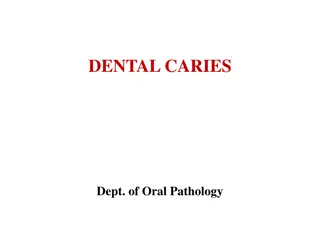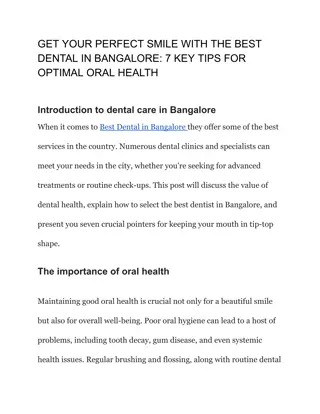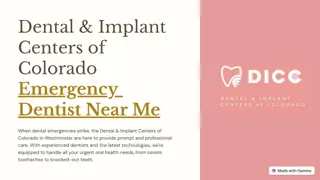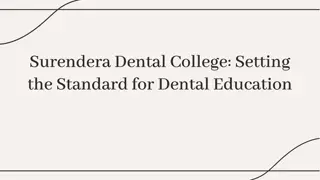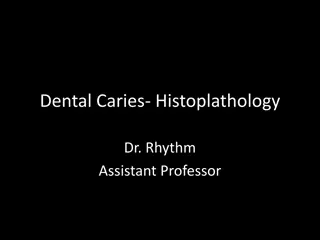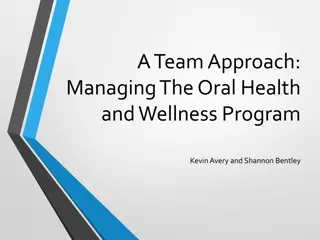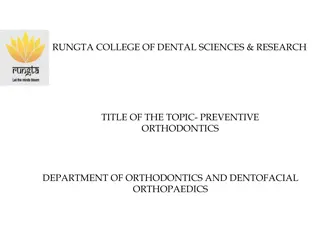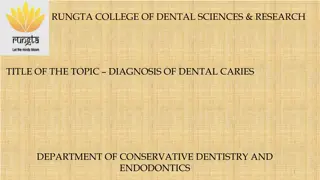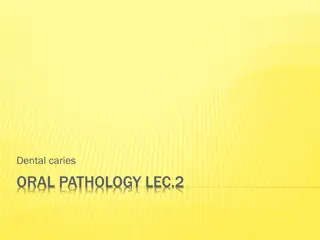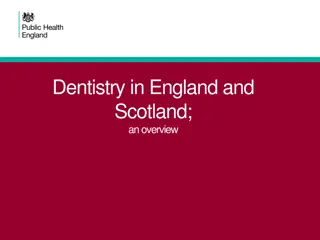Understanding the Relationship Between Diet and Dental Caries
Dental caries is a common chronic disease affecting all age groups, characterized by demineralization of tooth tissues due to microbial activity. Carbohydrates in the diet play a crucial role in caries development. Evidence shows a clear link between diet and caries incidence through various studies, highlighting the impact of sugar availability on dental health.
Download Presentation

Please find below an Image/Link to download the presentation.
The content on the website is provided AS IS for your information and personal use only. It may not be sold, licensed, or shared on other websites without obtaining consent from the author. Download presentation by click this link. If you encounter any issues during the download, it is possible that the publisher has removed the file from their server.
E N D
Presentation Transcript
DENTAL CARIES SEVERITY CLASSIFICATION SCALE
Dental caries is an infectious microbiologic disease of the calcified tissues of the teeth, characterized by demineralization of the inorganic portion and destruction of the organic substance of the tooth. It is a common chronic disease that leads to pain and disability across all age groups. The Dental Caries Process
Local dietary effects Dietary carbohydrate are caries conductive by the following points: All dietary sugars (sucrose, glucose, fructose, lactose) are used in the energy metabolism of plaque bacteria Carbohydrates can be used directly by bacteria or stored as intra or extracellular polysaccharides Fermentation of carbohydrate's by bacteria causes increase in the organic acid concentration mainly lactic acids, under-saturation of calcium and phosphate and tooth demineralization.
Carbohydrate nomenclature Monosaccharaides Glucose (dextrose) Fructose (fruit sugar) Galactose Invert sugar (50% fructose + 50% glucose) Disaccharides Sucrose (table sugar) Maltose Lactose (milk sugar) Trehalose (mushroom sugar) Natural and manufactured oligosaccharides (3 10 units) Polysaccharides ( 10 units) Starch
Evidence for a relationship between diet and dental caries comes from different types of studies Human intervention studies Human observational studies Animal experiments Plaque pH studies Enamel slab experiments Incubation studies
Epidemiological(observational) studies Population that had reduced sugar availability during the Second World War showed a reduction in dental caries which subsequently increased again when the restriction of sugar was lifted Isolated communities with primitive way of life and low sugar intake have low dental caries level. As such societies shift towards habits and diets of modern living(nutrition transition), marked increase in dental caries was observed People with high sugar consumption also have high level of caries like confectionary industry workers and children with chronic disease requiring long-term sugar-containing medicine
Human intervention studies Rare studies due to problems in trying to describe diet for long period of time Old studies conducted in pre-fluoride era on highly selected group of people Not possible to repeat due to ethical constraints Hopewood House study, Vipeholm study, Turku sugar studies
Hopewood House study Children living in the Hopewood House children s home in New South Wales received annual dental surveys between 1947 and 1962. A lacto-vegetarian one with an almost negligible amount of refined carbohydrates and the presence of minimal animal protein. Whole meal bread, soya beans, wheat germ, oats, rice and potatoes were the main sources of carbohydrates. The majority of the food were eaten uncooked - this was highly unusual, coupled with the fact that sugar, white flour and products made from these items were rarely included in meals. Fluoride content in the water and food consumed was also insignificant and meals and snacks were taken with great regularity.
Hopewood House study Dental caries levels were much lower than in children of the same age and socioeconomic background attending state schools in New South Wales 46% of 12-year-olds in Hopewood house were caries-free compared with 1% of the children from state schools. The Hopewood House study goes to show that in institutionalized children at least, dental caries can be reduced significantly, even without the beneficial influence of fluoride and in the presence of unfavorable oral hygiene. However, after 12 years of age, when the children s association with the home ended, the rate of caries increased to levels observed in children from the state schools.
The Vipeholm study The Vipeholm study was conducted shortly after the Second World War in an adult mental institution in Sweden between 1945 and 1953 The aim of the Vipeholm Study was to determine the relationship between diet, frequency of sugar intake and dental caries. The variables included the type of sugar ingested (sticky or non-sticky form) and the frequency of sugar intake (at meals or in between meals). The subjects (436 patients) were split into one control group and six main test groups, where the 'bread' and '24-toffee' groups were further divided into two separate groups according to gender.
The Vipeholm study The dietary regimes were given in two periods. The first carbohydrate period was between 1947 and 1949 and the second carbohydrate period in which the regimens were changed slightly between 1949 and 1951. A period of vitamin supplementation occurred for 1.5 years prior to the carbohydrate periods
The Turku sugar studies A second important intervention study was the Turku study. This was a controlled longitudinal study carried out in Finland in the 1970s The study investigated the effect of almost total substitution of sucrose in a normal diet with either fructose or xylitol on caries development Three groups of subjects (n = 125 in total) aged 12 53 years, with 65% being in their twenties, consumed a diet sweetened with either sucrose, fructose, or xylitol for a period of 25 months and dental caries increment was monitored blindly at six-month intervals
The Turku sugar studies Foods were specially manufactured for the fructose and xylitol groups and intake of starch was not restricted but subjects were asked to avoid sweet fruits such as dried fruits since sugars in these foods could not be substituted. xylitol group consumed significantly less frequently than the sucrose or fructose groups consumed their sweetened foods and the overall intake of xylitol in the xylitol group was lower than that of sucrose or fructose in the other groups The xylitol-containing foods
The Turku sugar studies An 85% reduction in dental caries was observed in the xylitol group who had removed sugar from their diet. Conclusions of the Turku study are that substitution of sucrose with xylitol resulted in a markedly lower dental caries increment in both cavities and at the pre-cavitation stage.
Animal experiments Animal experiments have enabled study of different types, concentrations, and frequencies of carbohydrates and sugars under specified conditions. It would not be possible to test such dietary regimens in humans due to problems of palatability and compliance. Animal experiments most commonly use the rat model; however, mice, hamsters, and monkeys are also used
Enamel slab experiments Enamel slab experiments use oral appliances that hold slabs of bovine or human enamel. Plaque forms on the enamel slabs that remain in the mouth for 1 to 6 weeks. The slabs are exposed to the dietary factor being tested, by either consumption with the slabs in situ or by removal of the appliances several times a day to dip into vessels containing the dietary test substances
Incubation studies Incubation studies are simple in vitro tests that measure if plaque bacteria can metabolize carbohydrate in a test food to produce acid. Pure cultures of micro-organisms may also be used in place of whole plaque. Rapid acid production and/or a low final pH is interpreted to mean that a food is potentially cariogenic, while a slow rate of acid production or higher final pH is likely to be of little clinical significance. All mono and disaccharides (10% solutions) produce a final pH of below 4.5 when incubated with plaque.
Plaque pH studies Plaque pH studies measure changes in the pH of plaque following consumption of a carbohydrate or carbohydrate-containing food. They measure acidogenic potential, which is taken as an indirect measure of cariogenic potential, although acidogenicity does not take into account protective factors in foods consumed and, salivary factors that may modify the carcinogenicity of a food.
Many factors can determine the shape of Stephan curve Site of dental plaque (less pH responses in lower jaw than upper jaw and anterior sites than posterior) The role of saliva in countering the pH drop Food acidogenicity Its easy to rank the relative cariogenic potential of foods by evaluation and comparing Stephan curves derived when such food are eaten under controlled condition. pH values differ in the plaque of sound tooth comparing with active and inactive lesions Buffering capacity of plaque
Types of sugar and dental caries Sucrose (the arch criminal of dental caries) is more cariogenic according to the animals experiments (the amount of plaque formed is not necessarily related to cariogenicity) Turku study showed no significant difference in caries development among subjects on diets sweetened with sucrose compared with fructose
Frequency of sugar intake and caries development The More occasions of sugar is taken, the greater the number of times plaque pH will bellow a level where demineralization can occur The primary evidence for the belief that the prevalence of dental caries is directly related to the frequency and to the form, in which sugar is eaten, comes from the Vipeholm study
Starches and dental caries conclusions: Cooked staple starchy foods such as rice, potatoes, and bread are of low cariogenicity in humans The cariogenicity of uncooked starch is very low Finely ground and heat-treated starch may cause dental caries but the amount of caries is less than that caused by sugars The addition of sugars increases the cariogenicity of cooked starchy foods. Foods containing cooked starch and substantial amounts of sucrose appear to be as cariogenic as similar quantities of sucrose
Fruit, vegetables and dental caries The preference towards whole fruits and vegetables is because these contain more non-starch polysaccharides and plant cell wall materials that benefit health. From a dental point of view, it is also preferable to consume whole fresh fruit as opposed to juices, because their mastication provides a good stimulus to salivary flow. In addition, fresh fruit juices contain non-milk extrinsic sugars, since liquidation releases the fruit sugars from the cellular structure of the fruit Dried fruit, potentially, may be more cariogenic; since the drying process breaks down the cellular structure of the fruit releasing extrinsic sugars
Protective food components Foods and food components that have anti-cariogenic properties are sometimes referred to as cariostatic factors Fluoride is undoubtedly the most effective of these factors. Dairy products, plant foods, tea, and even chocolate contain factors that protect against decay.
Milk and dental caries Normal milk consumption does not cause dental caries; and an inverse relationship between the consumption of milk and caries increment has been reported Cow s milk contains lactose, which is less acidogenic than other mono and disaccharides, and it also contains calcium, phosphorus, and casein, all of which are cariostatic. Human milk is more cariogenic than cow milk probably because of its lower mineral content and higher level of lactose. however, normal breast feeding does not cause dental caries. Prolonged and nocturnal suckling have been associated with increased caries risk
Cheese and dental caries Numerous animal studies and experimental studies have indicated that cheese is anticariogenic. Plaque pH studies have shown that consuming cheese following a sugary snack virtually abolishes the usual fall in pH that is associated with sugars consumption. Cheese stimulates salivary secretion, increased rate of sugar clearance due to the diluting action of cheese stimulated saliva increases plaque calcium and phosphorus concentration Both casein and cheese protein seem to be involved in the reduction of enamel demineralization and responsible for some anti-cariogenicity
Tea and apples There is increased interest in foods that contain polyphenols, as animal and experimental studies have shown that these compounds have antibacterial properties. Apples contain polyphenols and are a good stimulus to salivary flow. Tea also contains polyphenols in addition to fluoride Black tea extracts have been shown to inhibit salivary amylase activity and reduce dental caries in animal studies Polyphenols such as tannins found in cocoa, coffee, tea may reduce the cariogenic potential of glucosyltransfersase activity of MS which may reduce plaque formation. foods by interfering with
Fats Fats seem to reduce the cariogenicity of food Replacing carbohydrate in diet Form a protective barrier on enamel or surround carbohydrates, making these less available and speeding up their removal from the mouth Bacterial surface properties involved in plaque formation could also be altered by fats Certain fatty acid have anti microbial effects and have been shown to inhibit glycolysis in human dental plaque
Oral carbohydrate clearance The practical ways to speed up the carbohydrate clearance Tooth brushing immediately after meals Eating tough or highly flavored foods at the end of meal like fresh fruits and raw vegetables (detergent food) Eating peanuts or cheese immediately after sweet dessert to reduce the drop in plaque pH (apples generally didn t have this effect) Chewing paraffin or sugar free chewing gums Rinsing with water have a very limited effects
Oral carbohydrate clearance It is also advised to consume sugar-rich foods at mealtimes rather than alone, in between meals. This is because, when consumed with other foods the effect on pH is minimized probably due to (1) dilution effect (2) the increased salivary flow rate due to mastication of other foods.







